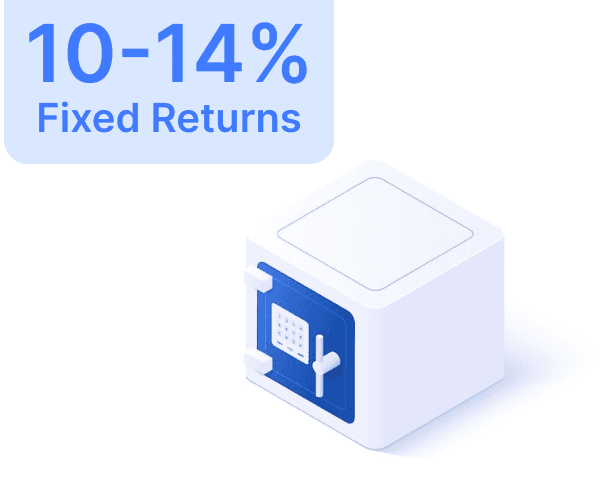Asset Under Management (AUM)



Introduction
Introduction
Introduction
Introduction
Asset Under Management (AUM) refers to the total cumulative investment sum of a particular mutual fund. It represents the overall market value that the fund holds, combining the value of all assets and capital. AUM is managed by fund houses, with fund managers overseeing the performance of these assets and making investment decisions to help investors achieve substantial capital appreciation. AUM serves as an indicator of a fund house's performance and size.
Asset Under Management (AUM) refers to the total cumulative investment sum of a particular mutual fund. It represents the overall market value that the fund holds, combining the value of all assets and capital. AUM is managed by fund houses, with fund managers overseeing the performance of these assets and making investment decisions to help investors achieve substantial capital appreciation. AUM serves as an indicator of a fund house's performance and size.
Asset Under Management (AUM) refers to the total cumulative investment sum of a particular mutual fund. It represents the overall market value that the fund holds, combining the value of all assets and capital. AUM is managed by fund houses, with fund managers overseeing the performance of these assets and making investment decisions to help investors achieve substantial capital appreciation. AUM serves as an indicator of a fund house's performance and size.
Importance of AUM in Mutual Funds
Importance of AUM in Mutual Funds
Importance of AUM in Mutual Funds
Importance of AUM in Mutual Funds
Indicates Fund Size:
AUM provides a clear glimpse of the mutual fund's size and scale. Higher AUM signifies that the mutual fund is well-established and likely to attract more investors.
Impacts Fund Performance:
AUM can affect the fund’s performance. Large AUM funds may find it challenging to generate high returns due to difficulties in finding suitable investment opportunities. Conversely, smaller funds might have more flexibility and potentially higher returns.
Affects Mutual Fund Fees:
A mutual fund’s AUM can impact the fees investors pay. Larger funds might have higher minimum investment requirements, limiting their accessibility to a broader range of investors.
Indicates Fund Size:
AUM provides a clear glimpse of the mutual fund's size and scale. Higher AUM signifies that the mutual fund is well-established and likely to attract more investors.
Impacts Fund Performance:
AUM can affect the fund’s performance. Large AUM funds may find it challenging to generate high returns due to difficulties in finding suitable investment opportunities. Conversely, smaller funds might have more flexibility and potentially higher returns.
Affects Mutual Fund Fees:
A mutual fund’s AUM can impact the fees investors pay. Larger funds might have higher minimum investment requirements, limiting their accessibility to a broader range of investors.
Indicates Fund Size:
AUM provides a clear glimpse of the mutual fund's size and scale. Higher AUM signifies that the mutual fund is well-established and likely to attract more investors.
Impacts Fund Performance:
AUM can affect the fund’s performance. Large AUM funds may find it challenging to generate high returns due to difficulties in finding suitable investment opportunities. Conversely, smaller funds might have more flexibility and potentially higher returns.
Affects Mutual Fund Fees:
A mutual fund’s AUM can impact the fees investors pay. Larger funds might have higher minimum investment requirements, limiting their accessibility to a broader range of investors.
Impact of High AUM on Mutual Funds
Impact of High AUM on Mutual Funds
Impact of High AUM on Mutual Funds
Impact of High AUM on Mutual Funds
Mutual funds with high AUMs can significantly influence their performance in the financial market. Fund houses often prefer asset-rich companies as they are more attractive to customers. Studies have shown that funds with higher AUMs tend to attract more investments and grow substantially over time.
Mutual funds with high AUMs can significantly influence their performance in the financial market. Fund houses often prefer asset-rich companies as they are more attractive to customers. Studies have shown that funds with higher AUMs tend to attract more investments and grow substantially over time.
Mutual funds with high AUMs can significantly influence their performance in the financial market. Fund houses often prefer asset-rich companies as they are more attractive to customers. Studies have shown that funds with higher AUMs tend to attract more investments and grow substantially over time.
Types of Funds and Their Relation to AUM
Types of Funds and Their Relation to AUM
Types of Funds and Their Relation to AUM
Types of Funds and Their Relation to AUM
Equity Funds:
Equity funds depend less on AUM and more on the asset manager’s skill to boost returns.
Debt Funds:
Debt funds benefit from a higher AUM as they can spread expenses across a larger investor base, reducing individual costs and increasing returns.
Small-cap Funds:
Small-cap funds are less affected by AUM unless the assets grow significantly, impacting the fund’s ability to manage investments efficiently.
Large-cap Funds:
Large-cap funds' returns are primarily market-driven and less dependent on AUM.
Equity Funds:
Equity funds depend less on AUM and more on the asset manager’s skill to boost returns.
Debt Funds:
Debt funds benefit from a higher AUM as they can spread expenses across a larger investor base, reducing individual costs and increasing returns.
Small-cap Funds:
Small-cap funds are less affected by AUM unless the assets grow significantly, impacting the fund’s ability to manage investments efficiently.
Large-cap Funds:
Large-cap funds' returns are primarily market-driven and less dependent on AUM.
Equity Funds:
Equity funds depend less on AUM and more on the asset manager’s skill to boost returns.
Debt Funds:
Debt funds benefit from a higher AUM as they can spread expenses across a larger investor base, reducing individual costs and increasing returns.
Small-cap Funds:
Small-cap funds are less affected by AUM unless the assets grow significantly, impacting the fund’s ability to manage investments efficiently.
Large-cap Funds:
Large-cap funds' returns are primarily market-driven and less dependent on AUM.
Calculation of AUM
Calculation of AUM
Calculation of AUM
Calculation of AUM
The AUM calculation process may vary among fund houses. AUM typically rises with consistent positive returns and new investments. Conversely, it decreases with market downturns or when investors redeem shares. The AUM fluctuates daily based on the market performance of the portfolio assets, with changes reflected at the end of each trading day.
AUM and Expense Ratio
The expense ratio, deducted from mutual fund returns, covers the costs of managing and operating the fund. The expense ratio depends on the size of the AUM, with larger funds incurring higher management costs. SEBI regulations ensure that the expense ratio remains below the AUM.
Difference Between AUM and NAV
AUM: Total market value of all assets held within a mutual fund, including stocks, bonds, and cash.
NAV (Net Asset Value): Market value of securities divided by the total number of units on a given date, computed daily based on asset performance.
AUM assesses a mutual fund’s size, while NAV determines the per-unit value of the fund for buying or selling shares.
The AUM calculation process may vary among fund houses. AUM typically rises with consistent positive returns and new investments. Conversely, it decreases with market downturns or when investors redeem shares. The AUM fluctuates daily based on the market performance of the portfolio assets, with changes reflected at the end of each trading day.
AUM and Expense Ratio
The expense ratio, deducted from mutual fund returns, covers the costs of managing and operating the fund. The expense ratio depends on the size of the AUM, with larger funds incurring higher management costs. SEBI regulations ensure that the expense ratio remains below the AUM.
Difference Between AUM and NAV
AUM: Total market value of all assets held within a mutual fund, including stocks, bonds, and cash.
NAV (Net Asset Value): Market value of securities divided by the total number of units on a given date, computed daily based on asset performance.
AUM assesses a mutual fund’s size, while NAV determines the per-unit value of the fund for buying or selling shares.
The AUM calculation process may vary among fund houses. AUM typically rises with consistent positive returns and new investments. Conversely, it decreases with market downturns or when investors redeem shares. The AUM fluctuates daily based on the market performance of the portfolio assets, with changes reflected at the end of each trading day.
AUM and Expense Ratio
The expense ratio, deducted from mutual fund returns, covers the costs of managing and operating the fund. The expense ratio depends on the size of the AUM, with larger funds incurring higher management costs. SEBI regulations ensure that the expense ratio remains below the AUM.
Difference Between AUM and NAV
AUM: Total market value of all assets held within a mutual fund, including stocks, bonds, and cash.
NAV (Net Asset Value): Market value of securities divided by the total number of units on a given date, computed daily based on asset performance.
AUM assesses a mutual fund’s size, while NAV determines the per-unit value of the fund for buying or selling shares.
What is Asset Under Management (AUM)?
AUM refers to the total market value of all assets managed by a mutual fund, indicating the fund’s size and performance.
Why is AUM important for mutual funds?
AUM indicates the mutual fund's size, impacts its performance and fees, and attracts potential investors by showcasing the fund's stability and growth potential.
How does AUM affect mutual fund fees?
Larger AUM funds might have higher minimum investment requirements and fees, impacting accessibility for some investors. The expense ratio, which covers fund management costs, is also influenced by the AUM size.
How is AUM calculated?
AUM is calculated by summing the market value of all assets managed by the fund. It fluctuates daily based on market performance and investor transactions, with changes reflected at the end of each trading day.
What is the difference between AUM and NAV?
AUM is the total market value of all assets in a mutual fund, while NAV is the market value of securities divided by the total number of units on a specific date. AUM assesses the fund’s size, while NAV determines the per-unit value for buying or selling shares.
What is Asset Under Management (AUM)?
AUM refers to the total market value of all assets managed by a mutual fund, indicating the fund’s size and performance.
Why is AUM important for mutual funds?
AUM indicates the mutual fund's size, impacts its performance and fees, and attracts potential investors by showcasing the fund's stability and growth potential.
How does AUM affect mutual fund fees?
Larger AUM funds might have higher minimum investment requirements and fees, impacting accessibility for some investors. The expense ratio, which covers fund management costs, is also influenced by the AUM size.
How is AUM calculated?
AUM is calculated by summing the market value of all assets managed by the fund. It fluctuates daily based on market performance and investor transactions, with changes reflected at the end of each trading day.
What is the difference between AUM and NAV?
AUM is the total market value of all assets in a mutual fund, while NAV is the market value of securities divided by the total number of units on a specific date. AUM assesses the fund’s size, while NAV determines the per-unit value for buying or selling shares.
What is Asset Under Management (AUM)?
AUM refers to the total market value of all assets managed by a mutual fund, indicating the fund’s size and performance.
Why is AUM important for mutual funds?
AUM indicates the mutual fund's size, impacts its performance and fees, and attracts potential investors by showcasing the fund's stability and growth potential.
How does AUM affect mutual fund fees?
Larger AUM funds might have higher minimum investment requirements and fees, impacting accessibility for some investors. The expense ratio, which covers fund management costs, is also influenced by the AUM size.
How is AUM calculated?
AUM is calculated by summing the market value of all assets managed by the fund. It fluctuates daily based on market performance and investor transactions, with changes reflected at the end of each trading day.
What is the difference between AUM and NAV?
AUM is the total market value of all assets in a mutual fund, while NAV is the market value of securities divided by the total number of units on a specific date. AUM assesses the fund’s size, while NAV determines the per-unit value for buying or selling shares.
Author

Harish Malhi
Read More 📖


Axis Bank Credit Card Net Banking
Axis Bank Credit Card Net Banking
August 5, 2024
August 5, 2024




PNB Fixed Deposit (FD) Interest Rates
PNB Fixed Deposit (FD) Interest Rates
August 5, 2024
August 5, 2024




Linking Aadhaar to Your Punjab National Bank Account
Linking Aadhaar to Your Punjab National Bank Account
August 5, 2024
August 5, 2024




PNB SIP Calculator
PNB SIP Calculator
August 5, 2024
August 5, 2024




How to Close a PNB Account Online & Offline?
How to Close a PNB Account Online & Offline?
August 5, 2024
August 5, 2024




TDS Refund - How to Claim TDS Refund
TDS Refund - How to Claim TDS Refund
August 5, 2024
August 5, 2024


View More




